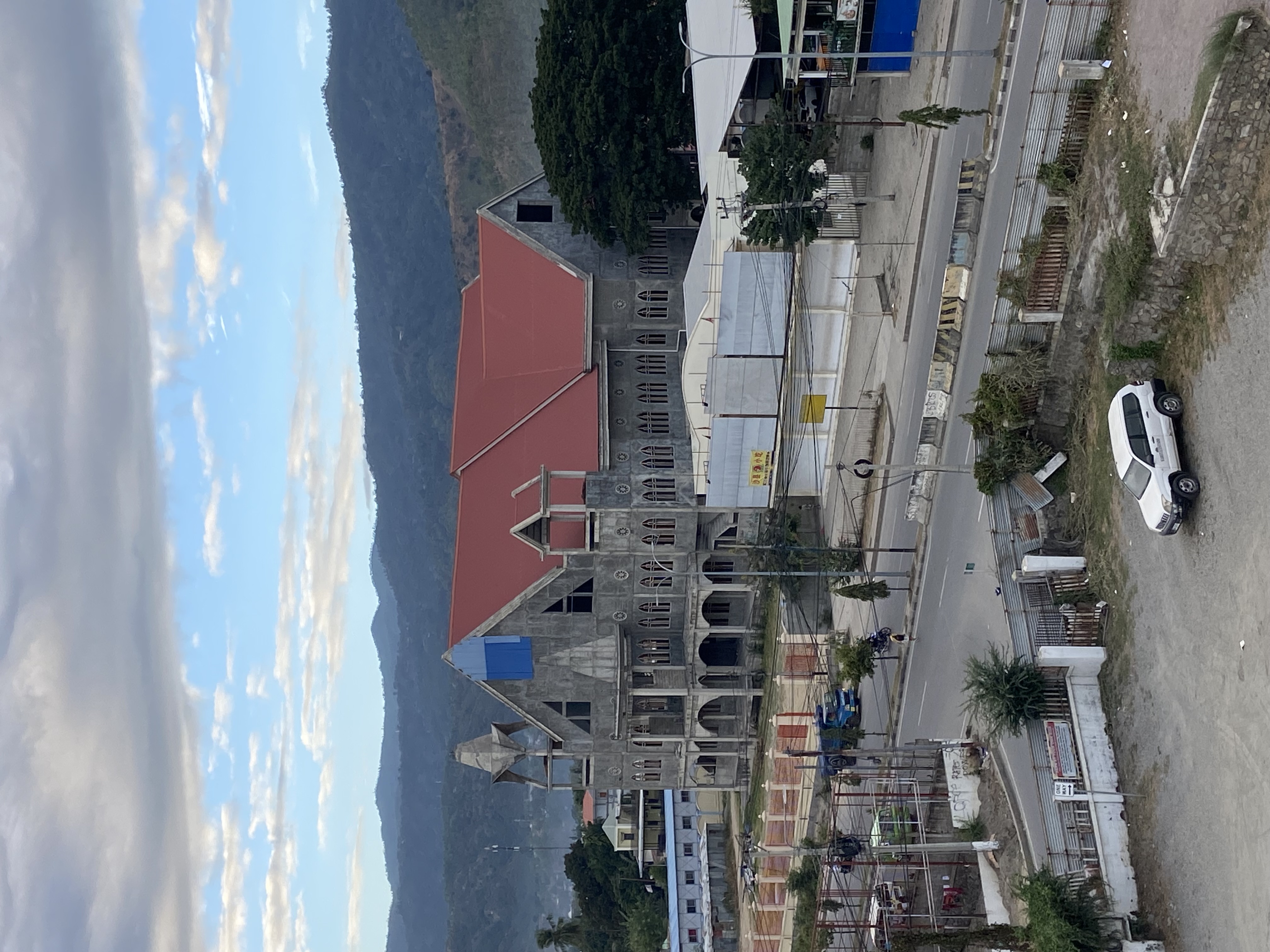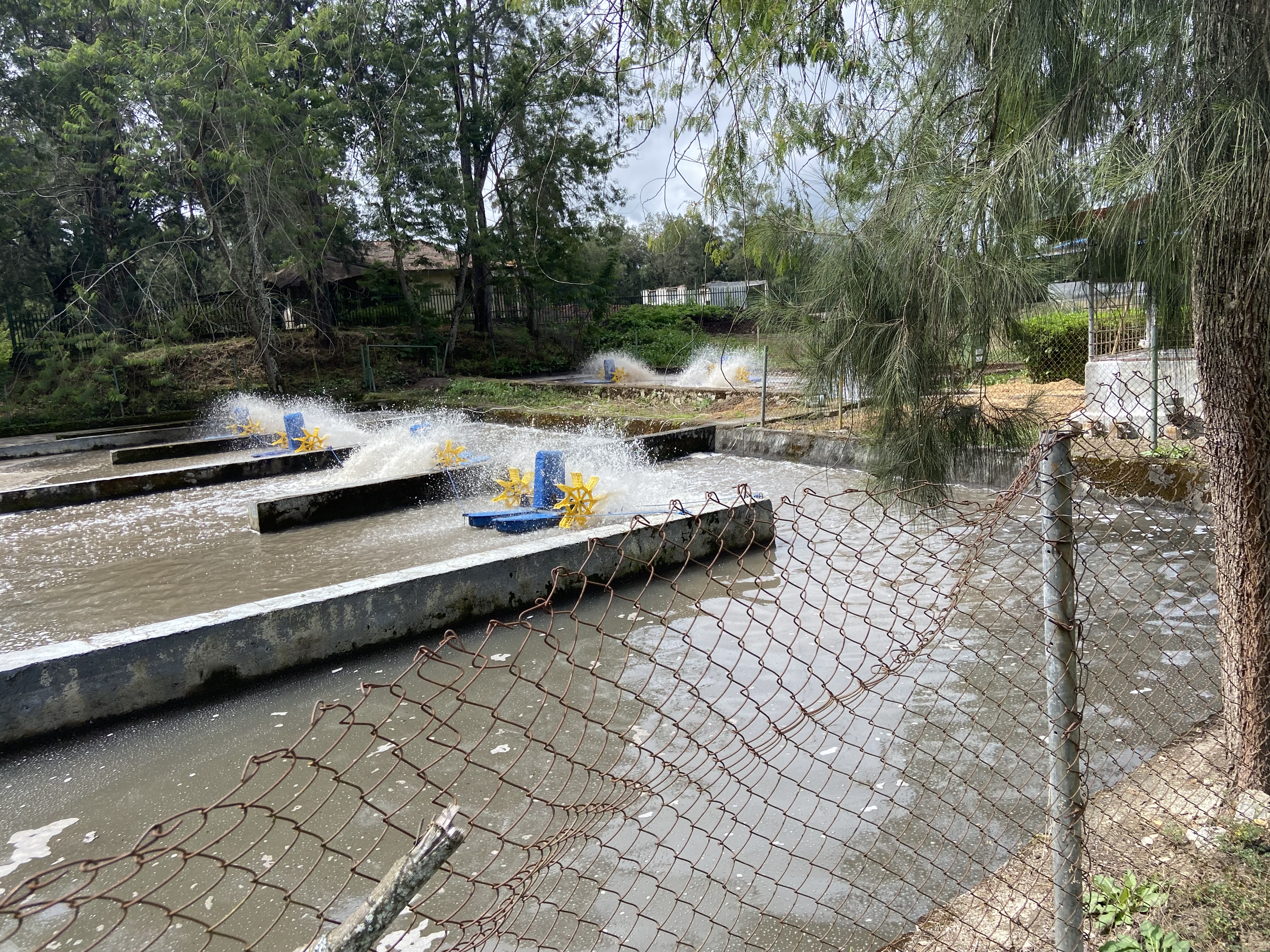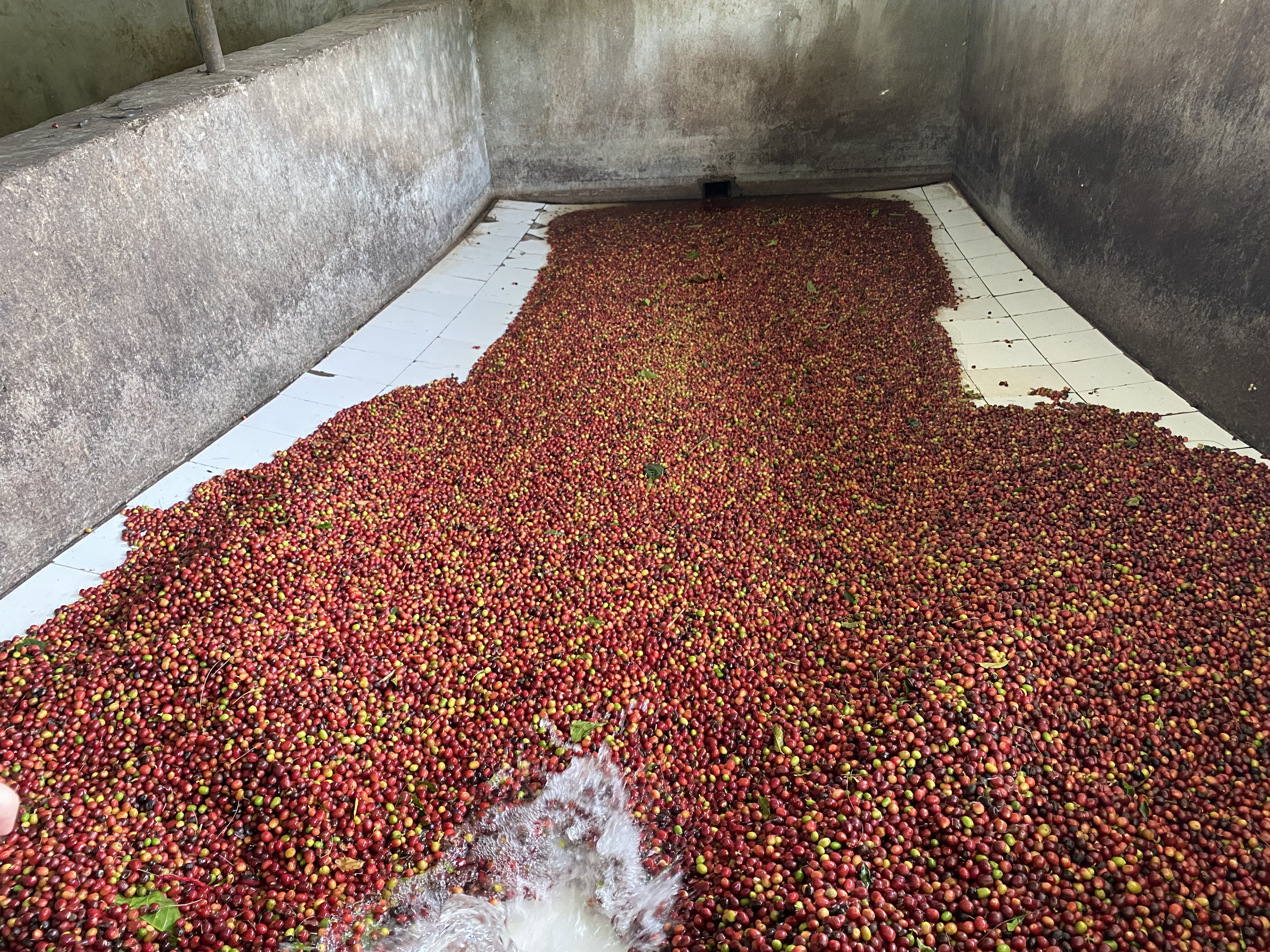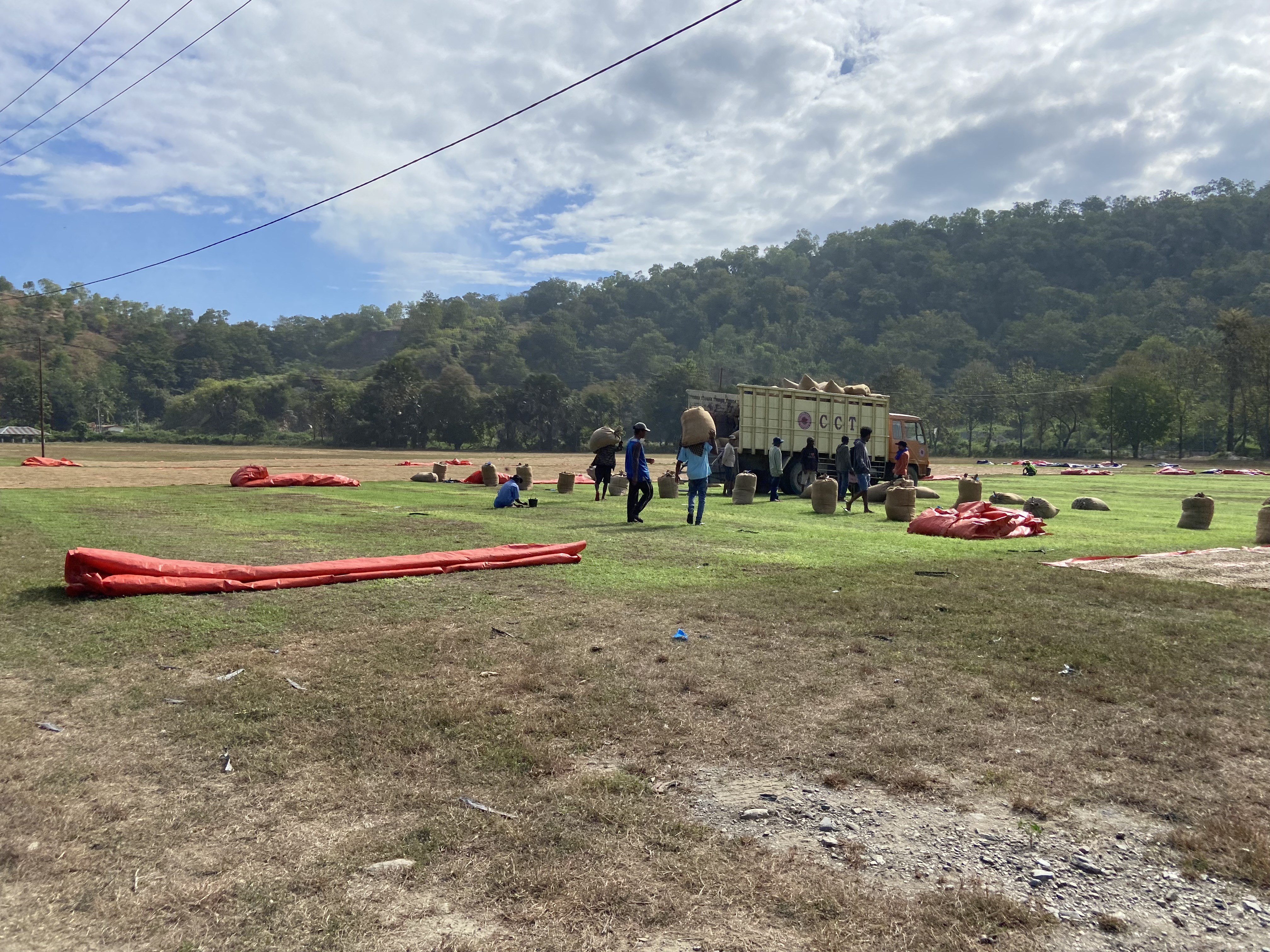Origin trip to Timor-Leste (or East Timor)
After finishing work and returning home, I joyfully said to my wife, "I'm going on a coffee farm trip to Timor-Leste! and I'm really excited." In response, my wife looked at me and asked me, "Where? Which country is Timor-Leste?"
Now, let me tell you about Timor-Leste or also known as East Timor, our close neighbour to Australia. It’s a newly established independent nation that has overcome many challenges and declared its independence from Indonesia about 20 years ago. With a population of 1.8 million people, 80% of whom are engaged in agriculture, Timor-Leste is known for its significant coffee production. Coffee beans are the country's third-largest export, and coffee trees can be seen growing alongside mountainous paths.
Timor Leste coffee, Timor Hybrid
When roasting coffee, you come across beans from many countries. Among them, Timor-Leste coffee is well known among roasters. Around 400 years ago, coffee trees were introduced to Timor-Leste from Portugal, and they began to grow in the fertile mountains of Timor-Leste.
The Timor Hybrid (Hibrido de Timor), a crossbreed between the Timor Hybrid and the Caturra variety, is cultivated in Timor-Leste. The Timor Hybrid is a natural hybrid between the Arabica and Robusta varieties, discovered in 1920 and believed to have played a significant role in the preservation of coffee-growing regions worldwide in the 1950s. As the name suggests, this variety is found in present-day Timor-Leste.

My journey starts
Travelling from Australia to Timor-Leste is a relatively short trip, as its a neighbouring country much closer to Australia than we might think. To land at the small airport in Dili, the capital of Timor-Leste, you only need to take a plane from Darwin International Airport and cross the sea, heading northwest for about 1 hour and 25 minutes. Living in Sydney, I realised how close Timor-Leste is to Australia, considering that it took me 4 hours and 20 minutes to fly to Darwin. (Well, Australia is vast, after all.)
Arriving in Timor-Leste the plane flew over the wide ocean from Darwin International Airport. Inside the plane, with a mixture of excitement and slight apprehension, I looked at the brochure provided on the flight and started eating the biscuits they had given. However, feeling a bit bored with the aeroplane brochure, I noticed that the view outside the window had already turned into green land.
I saw majestic, lush green mountains and scattered settlements occasionally visible in the mountains. Capturing the beauty of the coastal landscape, I took numerous photos with my phone camera while my mind wandered. Soon, the plane landed on the runway, and as I disembarked, I stood in line and headed to the tourist information counter. I paid $30 and received a tourist visa.
Timor-Leste has been using the US dollar as the country's currency since its independence with the help of the United States in 2003. Although they have introduced their own coins (called Centavos), they haven't yet issued their own bank notes, so if you pay US dollar notes then you will receive Timor-Leste’s Centavos coins as change.
Dili, the capital of Timor-Leste
As I was in the car with the coffee farm representatives who came to the airport to pick me up, I observed the streets of Dili. There weren't many buildings, and the few that existed didn't have a modern appearance. They seem to be built with very cheap materials, and along the main roads, many stores had their doors wide open, displaying clothes, vegetables, stacks of rice bags, and other food items allfull dust from the main road. However, in some places, large advertisements for mobile phone companies like Samsung were prominently displayed, contrasting with the humble buildings.
Many motorcycles and small minivans manoeuvred skillfully on the roads, almost like acrobats. Throughout the journey, I was startled by motorcycles suddenly squeezing past our car, and I instinctively pretended to step on the brake pedal in the backseat. However, the drivers and motorcycle riders seemed completely unfazed, as if all of this was part of their daily routine.
After a short drive, we arrived at Timor Plaza, the largest and most modern shopping mall in the capital. The mall had about five or six floors and had a contemporary design. Behind the same building, there was a hotel and accommodation facilities. At the back of the mall, another modern building was under construction, nearing completion. According to someone who had been to Timor-Leste ten years ago, these buildings weren’t there before, and there weren't as many cars and motorcycles on the roads back then. Clearly, the winds of modernisation had begun to blow in Timor-Leste as well.
The Cooperative Cafe Timor, CCT
The next day, we started our coffee trip with the people who do everything from growing coffee trees to exporting green coffee from Timor-Leste. They are called “Cooperative Cafe Timor”, abbreviated as “CCT”.
CCT was established in 1994 by representatives of coffee farms to promote economic development and improve the livelihoods of farmers in Timor-Leste, who had struggled for independence from Indonesia's regime. With the initial support of the United States Department of Agriculture (USDA) and the National Cooperative Business Association CLUSA International (NCBA), CCT has grown into one of biggest coffee processing business in Timor-Leste with its own coffee bean processing facilities and they currently have around 27,000 members from numerous small-scale local farms and employ 500 staff. They have taught modern coffee cultivation and processing methods to impoverished farmers, improving the quality and harvest of coffee. They cultivate various crops such as high-quality coffee beans, spices, cocoa, as well as assisting in their exportation to oversea markets.
The famous company Starbucks has been importing and selling coffee produced by CCT since the mid-1990s, resulting in significant coffee exports. And with a successful gain of the fair trade certification in 2001, Timor-Leste achieved a total coffee bean export value of $27 million in 2016 according to The Observatory of Economic Complexity (OEC).
However, Timor-Leste is still economically impoverished, relying on petroleum, natural gas, and coffee as its main sources of income.
 Coffee farm at Maubisse
Coffee farm at Maubisse
From Dili, we drove southward where the mountain road starts. along the way, we had to drive around large rocks, the size of the human head that had fallen from the mountainside onto the road. Also the road was filled with potholes caused by rain, and sometimes we had to pass through a section of road where the side of the road had collapsed. If you are planning a road trip in Timor-Leste, I highly recommend using a 4x4 or off-road vehicle.
However, there were many fascinating sights along the way. After driving south from Dili for about 40 minutes, we encountered a section where the entire road was flooded. On the side of the road, we witnessed the breathtaking scene of countless clear waterfalls flowing from the high peaks of the cliffs. Some people had parked their cars or motorcycles there, enjoying the magnificent and refreshing view, dipping their feet into the water. However, I could imagine that during the rainy season, the water might rise to the point where it would be dangerous to cross the road.
As we continued driving along the mountainous road, the view of Timor-Leste's valleys from the mountains was truly spectacular. An interesting aspect was the abundance of bamboo along the roads. The bamboo I saw in Timor-Leste was the largest and widest among the bamboos I had ever seen. Locals use these large bamboos as structural supports or widen them to use as exterior walls for buildings.
What surprised me most as we drove to a higher altitude of the mountain was the presence of coffee trees on both sides of the road. At first, I didn't recognise them as coffee trees as they were all tall and covered with road dust. Soon I noticed the coffee leaves, I realised that numerous coffee trees are growing vigorously along the mountainous paths. This was quite a shock to me, as I had always thought that coffee trees only grew neatly in the farms!

After driving for about two hours, our vehicle arrived at the entrance of Maubisse village. Soon, we passed by a market in Maubisse, bustling with many people selling their goods alongside the road. It was filled with loud voices, music, and the sounds of cars and motorcycles. It seemed to be a significant gathering place in this remote mountain village, far away from the city.
Maubisse village, located at an altitude of over 1,400 meters, has favourable conditions for producing high-quality coffee. In particular, Timor Hybrid, a crossbreed of Arabica and Robusta that evolved to be resistant to pests, thrives here. However, if the trees grow too tall, it becomes difficult for farmers to harvest the cherries on trees, reducing efficiency.
At the CCT Maubisse coffee farm (about 2 hectares), they provide free education on coffee pruning, spacing of coffee trees and soil fertilisation that helps increase the efficiency of coffee cultivation for farmers who own small-scale coffee farms.
During the coffee cherry picking experience, I had a chance to taste a coffee cherry that had turned deep red like blood from a well pruned tree. It had a high sweetness and juiciness. According to the farm representative, a well-maintained coffee tree can yield around 2 kilograms of cherries. However, traditional coffee farmers who have been traditionally harvesting coffee for a long time still believe that it is not a good idea to prune their trees as it may become smaller and yield less. Because they would like to harvest all cherries from the higher branches and sell more quantities, including un-mature cherries (green colour).--etcs---free-to-farmers-v1707363401795.png)
Coffee wet mill facilities at Estado & Railaco
Cherry harvested from small farms is transported by trucks to the facility, where it is washed in natural water flowing from the mountains and then passed through a wet milling machine to remove the pulp from the cherry. The thoroughly washed beans are left to ferment in tanks for 48 hours. Afterward, another process is carried out to remove the mucilage attached to the beans by rinsing them with high water pressure.
The wastewater generated from the mucilage treatment emitted a pungent and sour smell even from a distance. CCT has facilities for wastewater treatment, utilising air injection and chemical substances to decompose the wastewater before release to land. This traditional wet milling system produces a lot of wastewater. The Integrated Agricultural Centre in Railaco area, where CCT has introduced a wet mill system imported from Brazil in 2010, reduced the water required for processing from 20 liters to 5 liters per kilogram of beans.
At the Railaco facility, they have started using the pulped cherry husks to produce an organic fertiliser, which is a first in Timor-Leste. The coffee cherry husks generated almost as much waste as the coffee beans during the coffee processing, and they utilised this waste to produce natural fertiliser, distributing it for free to farmers or selling it in 25 kg bags for $5, generating additional income.
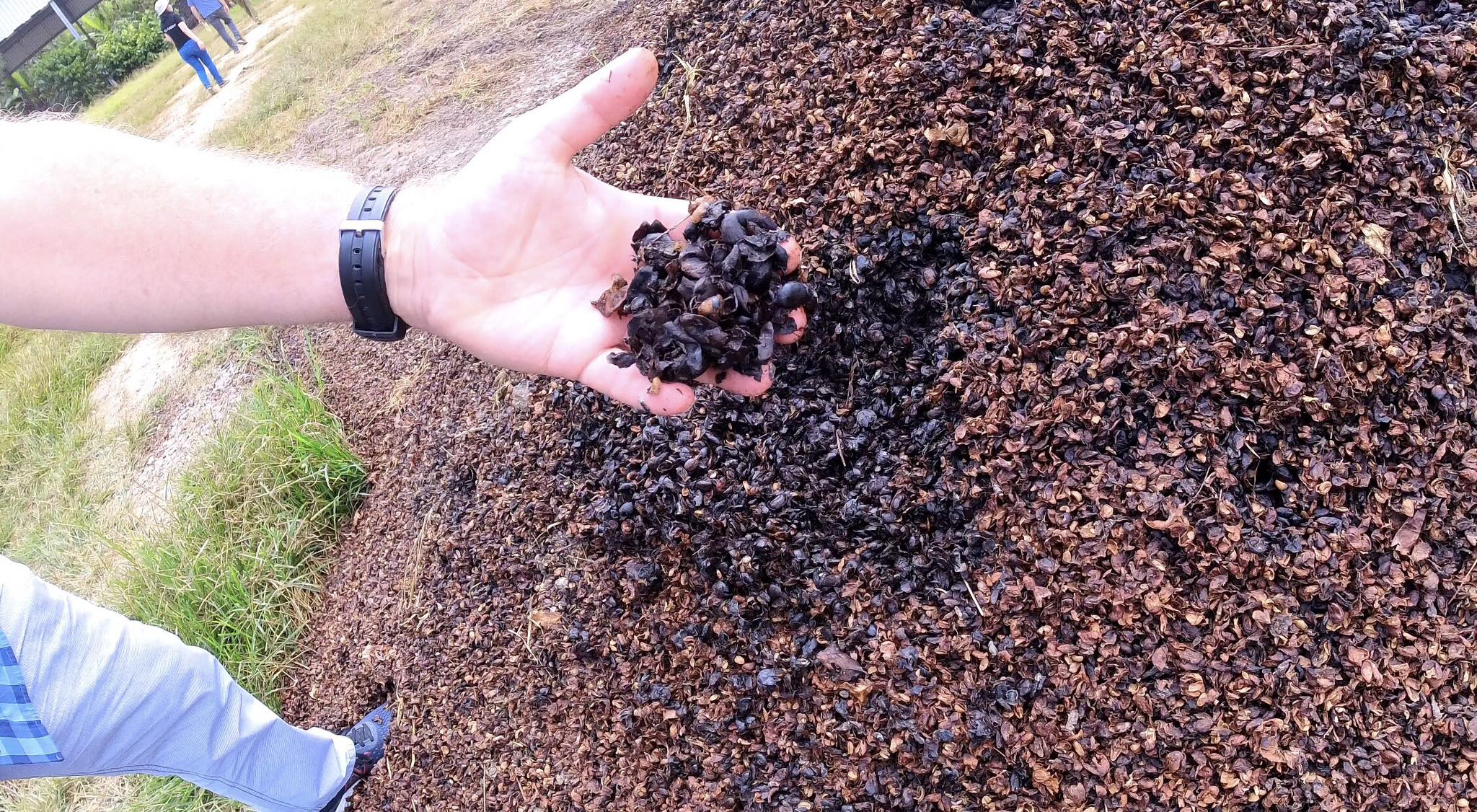
Central drying district located at Tibar
In this vast plain of 100 acres, pulped coffee beans are dried after the wet mill process. Wet coffee beans are spread out on a waterproof tarp and workers mix them every hour with a large fork-like tool under Timor-Leste's hot sun for five days. Every night or when rain is expected, the coffee is covered with tarp beneath it and moved inside the warehouse. This process is repeated for five days.
After five days of drying, the beans are placed in 40 kg bags and stored in a dry warehouse for at least 20 days, and in some cases, up to three months, with continuous moisture monitoring. The bags contain extensive information about the coffee, which allows for traceability which is a crucial factor in fair trading.
The final stage - dry coffee bean processing facility near Dili
The next destination was a dry mill facility located near Dili. Here, the dried beans are transported by truck and undergo a series of processes involving various machines and human hands to select only the best quality coffee beans. The process is as follows:
- First, the weight of the bags containing the coffee beans is measured.
- Pre-cleaning machine: Removes any impurities mixed with the coffee.
- De-stoner: Filters out small, hard impurities that may be mixed with the coffee beans.
- Hulling/polishing machine: Removes the dry mucilage remaining on the surface of the beans.
- Size grading machine: Divides the coffee beans into different grades based on size by vibrating the beans on up to six different screens.
Gravity grading machine: Divides the beans into different grades based on weight and density. Even if beans are the same size, they can have different densities, which can affect the taste after roasting and can be problematic if the beans are hollow. Therefore, this is an important sorting process.

The sorted coffee is transferred to the other side of the factory through a large pipe, separated by a central wall. From the moment the beans enter the destoner, the transportation of the coffee from one machine to another is automated through pipes connecting each machine. There are also strong magnets at intervals to filter out metallic particles.
Colour sorting machine: This sophisticated and expensive machine scans the colour of the beans and selects those that do not meet the specified spectrum of colours. It works by scanning the beans at a tremendous high speed, pushing out the rejected beans with air. According to the representative, it can process up to 6 tons per hour.
Hand sorting process: The final sorting process involves human hands, where the beans are put into coffee bags. Instead of sorting beans from the piles, the beans are spread thinly on a conveyor belt, allowing them to come out slowly and evenly. People select the coffee as it moves along the conveyor. The sorted coffee is automatically transferred to the packaging area, where it is packed into 60 kg bags ready for export. This automation and processing process not only improves production but also reduces the chance of overlooking defective beans.
Vanilla bean processing facility
Although CCT primarily exports 90% coffee beans, they also engage in processing and exporting vanilla, cocoa, and spices, opening up alternative income sources for many farms. When we arrived at the Vanilla processing plant near Dili, the floor of the facility was filled with people processing vanilla beans.
The thin and dried brown colour vanilla beans that we commonly find on the supermarket are initially green colour and are longer.

Assorting process is performed by hand before being placed in GrainPro bags or similar bags that provide an atmospheric barrier. The beans are then exposed to sunlight for heat treatment and fermentation. Afterward, the vanilla is removed from the bags and placed on drying screen beds, where it is completely dried for about a month to become the brown vanilla beans we are familiar with.
According to CCT, the price of high-quality vanilla beans has dropped by more than 80% in the past five years. However, as farmers can produce 1 kg of vanilla beans from a single tree, it has become an additional source of income for them.
The Clinic Café Timor at Mulo
We visited a free clinic sponsored by CCT on our trip. We travelled to a rural area at Mulo, where there is a very small community of farmers scattered around the mountains. In particular, this is where pregnant women give birth and care for their children. CCT says that 40% of the proceeds from its exports, along with grants from the government, are used to fund a few free clinics with equipment, medicine and training nurses. It's a great help to the people of these mountain villages, who are still very poor and hospitals are too far and expensive for them. So when we buy a Timor-Leste coffee, we are also creating a positive impact for these resilient people.
Finishing my trip story
From magazines and the internet, most people seem to have a general idea of the environment and the coffee cultivation process in a country without actually visiting it. Personally, I often look at the coffee processing diagram with cute LEGO workers on the poster on the wall of my workplace.
During my first coffee trip to Timor-Leste, riding a 4x4 vehicle and traversing rough roads, passing waterfalls, and visiting coffee cultivation facilities, I was deeply impressed by the culture and way of life of the people working there. They are a young nation that has achieved independence after being colonised by other countries, and although they still live in poverty and face economic hardships, the people of Timor-Leste, who are starting everything anew, were always kind and gentle.

The untouched nature, coffee trees spread across the mountains, and the people working for the coffee industry and the well-being of the community, such as CCT, make me believe that Timor-Leste's coffee industry will continue to thrive.
** Big thanks to Pablo and Rusty's Coffee Roaster for offering me this fantastic opportunity and also would like to extend my sincere gratitude to Bennets Australia Teams and Cooperative Cafe Timor for making this trip possible.

